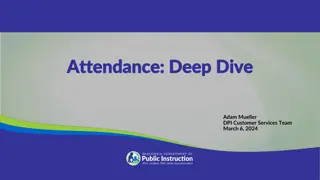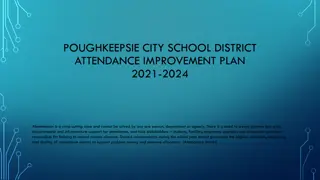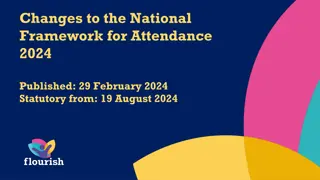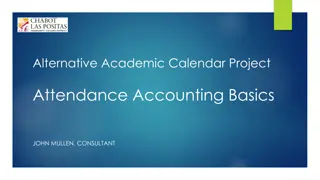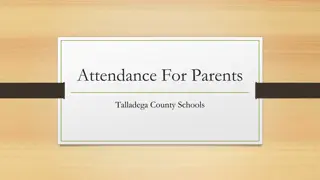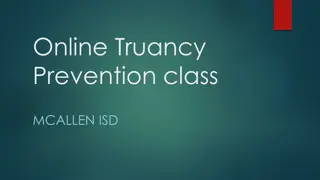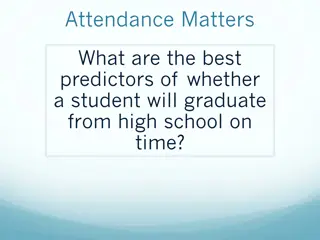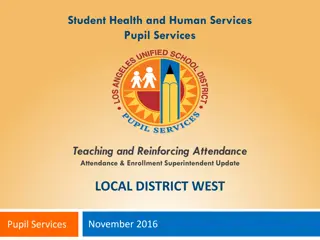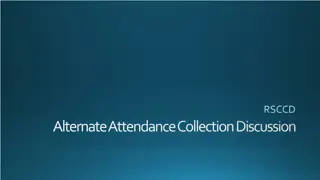Enhancing School Attendance through Strategic Partnerships: Insights from Pilot Programs
The ongoing challenge of improving school attendance post-pandemic is addressed through strategic partnerships and pilot programs focusing on vulnerable young people. Insights from initiatives like the Wakefield Integrated Education Partnership and LocalED 2025 pilots highlight the importance of holistic approaches and system-wide collaboration in tackling attendance issues. Key takeaways emphasize the role of strategic partnerships in addressing complex educational challenges.
Download Presentation

Please find below an Image/Link to download the presentation.
The content on the website is provided AS IS for your information and personal use only. It may not be sold, licensed, or shared on other websites without obtaining consent from the author.If you encounter any issues during the download, it is possible that the publisher has removed the file from their server.
You are allowed to download the files provided on this website for personal or commercial use, subject to the condition that they are used lawfully. All files are the property of their respective owners.
The content on the website is provided AS IS for your information and personal use only. It may not be sold, licensed, or shared on other websites without obtaining consent from the author.
E N D
Presentation Transcript
Educating for the future: developing new locality models for English schools Pilot 1 Support for Vulnerable Young People Developing a partnership focus on attendance November 2023
Attendance The issue everyone is talking about, and nobody has cracked The coronavirus pandemic had an undeniable impact on the education of children across the country, almost two years on from the first lockdown we are still trying to understand just how deep that impact runs. Fundamental to any model for improving attendance is improving the support available to children and their families. while [quantitative] data paints a stark picture, it does not tell us anything about why attendance rates have plummeted following the pandemic. Attendance has always been a symptom rather than a cause, a manifestation of complex issues across the education system and beyond. covid-19 and its aftermath has had a damaging effect on school attendance, which has lasted longer than originally anticipated Families are struggling with high school costs, and in some cases, fining is not an appropriate, compassionate, or helpful response. Pupils who attend regularly and those whose attendance improved are more likely to pass their GCSEs in Year 11 We do not know why school attendance improved for this cohort. Other agencies, such as health, social care, transport, and housing, must view daily attendance at school as a priority and must play their role in establishing a local authority wide approach to attendance. 2
Three things I want to cover today 1. Attendance as a priority for a local system s strategic partnership Learning from the Wakefield Integrated Education Partnership, 2022/23 2. Piloting holistic approaches to supporting vulnerable children Learning from the LocalED 2025 pilots 3. The role of a strategic partnership on system-wide issues like attendance Key take-aways 3
In 2022/23, the newly-formed Wakefield Integrated Education Partnership identified attendance as a priority Newly established formed summer 2022; first year of operation AY22/23. Purpose identify and address long-term strategic system-wide issues facing the local education system to improve outcomes for all young people. Priorities agreed to focus on attendance as one of three strategic priorities in its first year. Background Clear purpose clear on what the partnership is (strategic, ethical system leadership, on cross-cutting issues not being dealt with elsewhere) and isn t (operational; school improvement; funder). Membership tight group; representative and networked (reflective of schools and trusts, links with key school leader associations; key senior LA and health service decision-makers); clear expectations (esp. comms). Priority-setting what should / not be a priority (ongoing vs deep dive). Data and intelligence evidence base to inform partnership discussions. Learning about what works in establishing a strategic partnership Act as a guiding coalition (not another group of critics ). Create the conditions for a whole-system approach bring leaders together, create mandate for the work. Test a new strategy or approach segmentation (different groups, cohorts, needs); principles; roles; capture best practice; test solutions. Articulate and underscore key messages system speaks with one voice . Scrutinise intelligence systematically identify and address blockages. Attendance as a priority: What the partnership can (not) do 4
Three things I want to cover today 1. Attendance as a priority for a local system s strategic partnership Learning from the Wakefield Integrated Education Partnership, 2022/23 2. Piloting holistic approaches to supporting vulnerable children Learning from the LocalED 2025 pilots 3. The role of a strategic partnership on system-wide issues like attendance Key take-aways 5
LocalED 2025: The aims of pilot 1: Support for vulnerable children What the pilot is seeking to test and learn about The pilot is seeking to test locality-based, needs-focused, holistic approaches to identifying, understanding and meeting the needs of vulnerable young people and avoid reducing young people to specific labels or points in datasets. We are interested in approaches that seek to bring together leaders across a local system education leaders, people-based services and wider partners within specific localities (communities, neighbourhoods, townships) that seek to increase the visibility of vulnerable young people, their experiences and the causes of vulnerability and non-attendance, to leaders within the local system and at a locality level and foster collective responsibility for vulnerable young people; and use this to drive decision-making and actions about strategies and approaches that will strengthen support for vulnerable young people and ultimately deliver impact and improve lived experiences and outcomes. 6
LocalED 2025 The issues the pilots are seeking to address 7
Reflections and learning What is needed to develop holistic, needs-led, locally-based approaches? Data can only take us so far and some young people can be hidden by data. Understanding and addressing vulnerability requires a granular, qualitative, dialogue- and relationships-based approach why? how can we help? . Need to start somewhere huge value in exploring small number of well- selected cases, working with the young people, families, professionals. #1. Seeing young people holistically What do we mean by locality ? 1. Permission to work in a more joined-up way services, professionals and settings being able to work in a more flexible, holistic, joined-up manner. 2. Strategic partnerships regularly looking at intelligence and learning from individual cases being more operational in order to be more strategic . Testing the system s principles and aims against young people s experiences. #2. The role of locality Vulnerable young people have needs that go beyond common approaches. They often require something more bespoke and multi-faceted. That requires focusing on influencing practice and interactions between professionals and an individual young person compassion, relationships. This has implications for capacity and skills it puts a premium on being able to foster relationships with young people, families, schools and professionals. #3. Practice, relationships and capacity 8
Three things I want to cover today 1. Attendance as a priority for a local system s strategic partnership Learning from the Wakefield Integrated Education Partnership, 2022/23 2. Piloting holistic approaches to supporting vulnerable children Learning from the LocalED 2025 pilots 3. The role of a strategic partnership on system-wide issues like attendance Key take-aways 9
Drawing this together: The role of a strategic partnership on system-wide issues like attendance 1. Strategic partnerships have a vital role to play in fostering whole-system approaches to attendance / vulnerable children creating the mandate , underscoring key principles, ensuring visibility . 2. Comparing the local system s ambitions, principles and strategies with the lived experiences of young people partners putting themselves in a position to consider, in granular detail, causes and experience of young people s non- attendance and vulnerability, how this does / not match the system s overall ambitions, and what action needs to be taken at system level as a result. 3. Focusing on influencing practice recognising that a strategic partnership is not an operational, doing body; using existing capacity within members organisations and services to focus on influencing and enabling practice and interactions at a granular, individual level. 10






